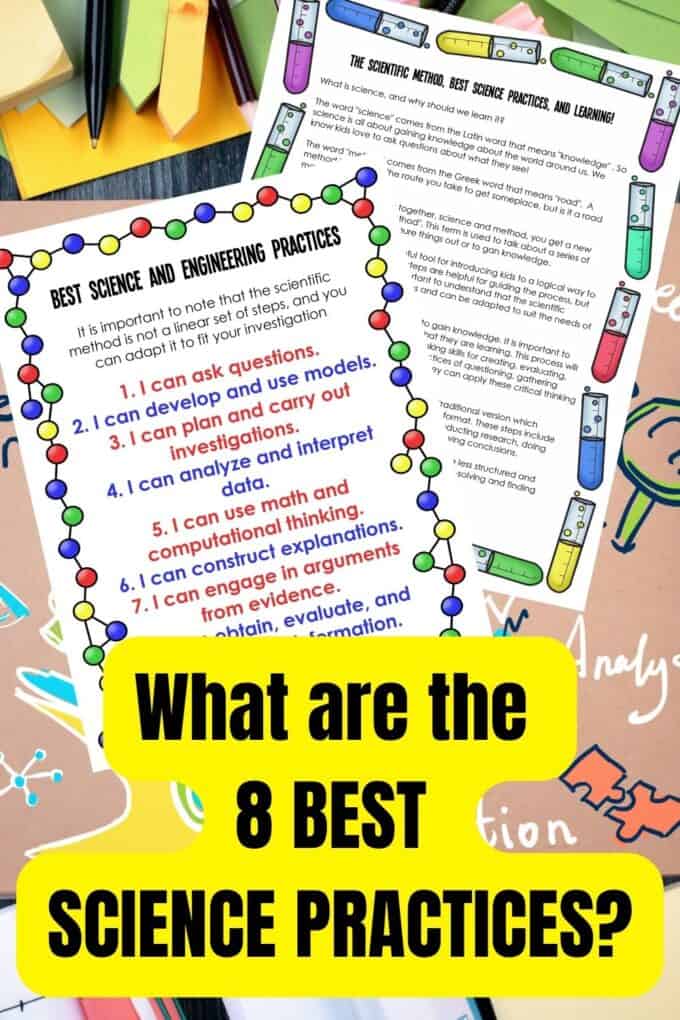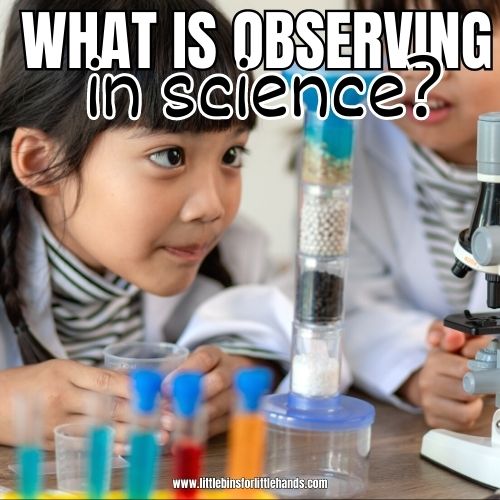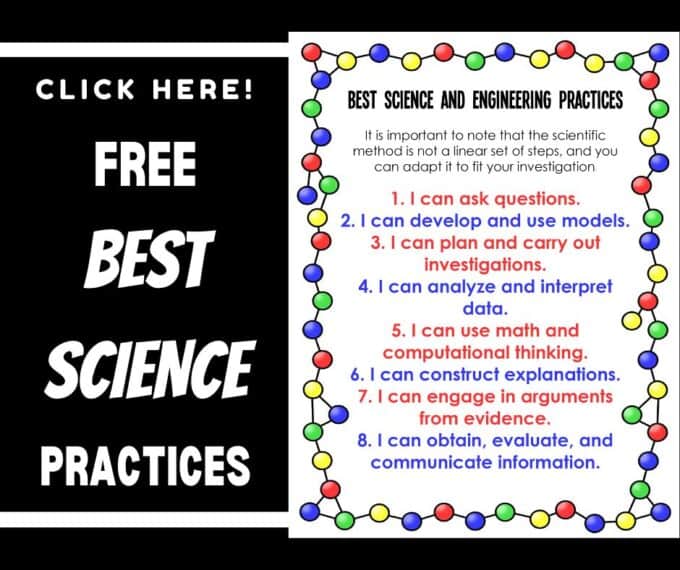Another use of the scientific method can be seen here, along with the best science and engineering practices, which are a little less linear. Why don’t we dive in and take a look at the 8 science and engineering practices and examples of them?

WHAT ARE SCIENTIFIC PRACTICES?
The word “science” comes from the Latin word “knowledge”. So science is all about gaining knowledge about the world around us. But how do scientists come up with that knowledge? In a systematic way that involves lots of observation and experimentation!
The best science and engineering practices below are behaviors that kids can demonstrate as they develop an understanding of science topics and concepts.
They may look less structured than the traditional scientific method, and allow for a more free–flowing approach to problem-solving and finding answers to questions. However, these skills are critical to developing future engineers, inventors, and scientists!
It is essential to allow kids to use the practices with whatever they are learning. This process will encourage the use of higher-order thinking skills for creating, evaluating, and analyzing.
As kids develop the practices of questioning, gathering data, analyzing, and communicating, they can apply these critical thinking skills to any situation. Now that’s a winner!
* Note: You might be familiar with the more traditional scientific method, which includes some similar practices but in a linear format. These steps include asking questions, developing a hypothesis, conducting research, doing experiments and tests, analyzing data, and drawing conclusions.
8 SCIENCE AND ENGINEERING PRACTICES
ASKING QUESTIONS
Asking questions is an integral part of discovering and learning new things. In science, good questions help scientists discover more about the world and how it works.
Asking questions is a fundamental skill for kids to develop. When kids are curious about something, they ask questions. Introduce kids to science activities and themed science centers, and even go out into nature to stir curiosity about the world around them.
Teach kids to ask scientific questions. Scientific questions are defined, can be tested, and can be answered using data. Show kids how to develop good scientific questions by brainstorming possible questions and eliminating any that are too broad and can’t be tested.
The practice of asking questions can be informal, such as in class or small group discussions, or formal, such as written questions. See our questions for reflection.
DEVELOPING AND USING MODELS
Kids might think of models as smaller copies of real cars or planes. In science and engineering, models represent ideas, events, or processes.
Models can help explain complex ideas more simply. They are based on observations and current explanations about how things work. But because they are simplified, they can’t represent every detail. Good models can be tested and redesigned and used to improve predictions.
Maps, drawings, diagrams, 3-D structures, and physical models are examples of models kids may use to develop understanding.
PLANNING AND CARRYING OUT INVESTIGATIONS
Kids can practice planning and carrying out investigations with hands-on science activities that answer a question or test the solution to a problem. A simple plan may include a list of materials needed and the steps to be taken.
A more involved investigation will include identifying relevant variables and considering how they might be observed, measured, and controlled. Kids will need to think about how they will collect and record the data and the time frame needed for the investigation.

💡 Observation is a powerful science tool! Kids are naturally observant!
ANALYZING AND INTERPRETING DATA
Data are the observations and measurements that you collect to answer a question. Before they can be useful, though, data needs to be analyzed and interpreted. Data can be organized with tables, graphs, and other means to help reveal patterns or relationships.
When kids examine the data they have collected, they need to identify anything significant and anything that may be an error. Interpretations of the data are not facts or personal opinions but suggestions about what they mean.
USING MATH AND COMPUTATIONAL THINKING
Kids need to understand how math and computer programs are connected to observations, experiences, and ideas about the world around them. This begins with an awareness of mathematics in science.
Using math and computational thinking for kids can be as simple as recognizing and describing the number patterns they see around them. They can describe, measure, and compare quantities and record them in a graph. Then, they can use quantities such as area, volume, weight, and time to answer scientific and engineering questions and problems.
CONSTRUCTING EXPLANATIONS
You want kids to be able to form their explanations rather than just having the science content explained to them. Explanations can be communicated using words, pictures, and numbers; this will take lots of practice for many kids.
Teach kids how to construct explanations in science by getting them to write down what they are thinking. Start with a sentence about what they think the answer is. Then, state the evidence, which is exactly what they observed. Finish with the “because,” which is the scientific principles they have been learning about.
ENGAGING IN ARGUMENTS FROM EVIDENCE
Engaging in arguments is important for kids because it makes explanations or solutions much clearer. It also helps kids learn to differentiate between evidence and opinion and receive and respond to feedback from others.
Often, this process starts with a question, which may have multiple potential answers. Why do you think this is happening? Those possible answers are known as claims. The evidence comes in the form of observations or data, and kids need to work through the evidence that supports the different claims.
OBTAINING, EVALUATING, AND COMMUNICATING INFORMATION
Scientists and engineers must be able to gather information and communicate their findings. Scientific literacy for kids includes finding out, evaluating, and communicating scientific information. Information can be gathered from age-appropriate texts like teacher-recommended STEM, engineering, or science books, videos, and media.
Communicating information can happen in multiple ways. Kids could use words, diagrams, graphs, images, models, interactive displays, discussions, or oral presentations. Provide lots of opportunities for kids to talk about their learning and present their findings differently!
CLICK HERE TO GET YOUR FREE SCIENCE PRACTICES PRINTABLE

SCIENCE VOCABULARY
It is never too early to introduce some fantastic science words to kids. Get them started with a printable science vocabulary word list. You’re going to want to incorporate these simple science terms into your next science lesson!
WHAT IS A SCIENTIST
Think like a scientist! Act like a scientist! Scientists like you and me are also curious about the world around them. Learn about the different types of scientists and what they do to increase their understanding of their specific areas of interest. What Is A Scientist
SCIENCE BOOKS FOR KIDS
Sometimes, the best way to introduce science concepts is through a colorfully illustrated book with characters your kids can relate to! Check out this fantastic list of teacher-approved science books, and get ready to spark curiosity and exploration!
Check out our recommended book lists:
